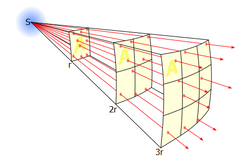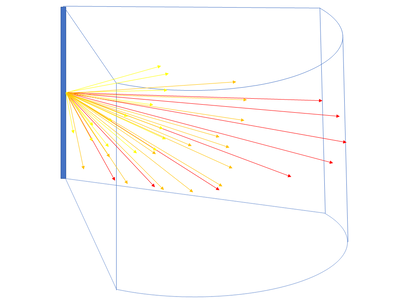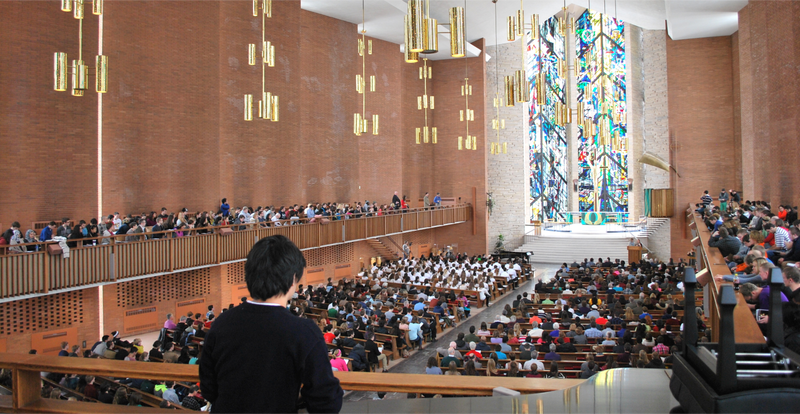Sound Planning has been installing and integrating steerable line-array loudspeakers since they started to arrive in the early 2000s. It started with Duran Audio (now part of Harman / JBL Professional) and Renkus Heinz Iconyx. After many iterations, the industry has created a technology that solves problems that could not be addressed in past years of loudspeaker designs.
Our team has designed systems in:
Our team has designed systems in:
- St. Alphonsus Catholic Church, Chicago
- St. Mary Catholic Church - Huntley, IL
- Chapel of the Resurrection at Valparaiso University
- St. John Cantius Catholic Church, Chicago
- Anshe Emet Synagogue, Chicago
- Episcopal Church of the Atonement, Chicago
- Fourth Presbyterian Church, Chicago
- The Field Museum (Stanley Field Hall), Chicago
- Bahá’í House of Worship of North America
|
|
How Loudspeakers are Chosen for a Project:
A great sound system requires decisions about the appropriate loudspeakers that suit the acoustic environment and audio program needs. Not every loudspeaker behaves the same way. This is not a brand or manufacturer matter. This is a principal of the acoustic and electronic components that comprise a loudspeaker system as well as the physics of sound. How does Sound Planning choose the right loudspeaker system for the project?
There are many factors, but most simply: BUDGET, INTENT and BUILDING TYPE
BUDGET
If you cannot afford the solution, there is no point in designing one. We put this at the front of the list to find what loudspeaker system will deliver the best results while not breaking the budget.
INTENT
Is the system spoken word or speech-range only? If there is live music, what type of levels will be appropriate for the audience?
BUILDING TYPE
What are the acoustics of the space like? Will the loudspeaker design fill the audience area with the intended sound? Will the loudspeakers work well with the room acoustics or negatively excite the room?
With these simple factors, we can now look at the type of loudspeaker systems and discover why we would select them for a project. Bear in mind that we are not even choosing a brand, make or model; we are just talking about the sound propagation properties for a loudspeaker design.
Types of loudspeakers: line-source vs point-source
Line-Source and Point-Source are physical properties that are in theory possible, but in reality, each manufacturer and model will deliver a proximity to the theoretical properties that their design will allow. I.E. your mileage may vary.
A Point-Source is the most common loudspeaker type. In fact, all loudspeakers are a point-source type. It is a combination of loudspeakers that may create a line-source. These speakers deliver sound from a point in space. But because they are actually larger than one point in space, they are only a “point” in the calculation of its source origin.
A point will behave like light or other point sources in that it fits within the inverse square law.
A great sound system requires decisions about the appropriate loudspeakers that suit the acoustic environment and audio program needs. Not every loudspeaker behaves the same way. This is not a brand or manufacturer matter. This is a principal of the acoustic and electronic components that comprise a loudspeaker system as well as the physics of sound. How does Sound Planning choose the right loudspeaker system for the project?
There are many factors, but most simply: BUDGET, INTENT and BUILDING TYPE
BUDGET
If you cannot afford the solution, there is no point in designing one. We put this at the front of the list to find what loudspeaker system will deliver the best results while not breaking the budget.
INTENT
Is the system spoken word or speech-range only? If there is live music, what type of levels will be appropriate for the audience?
BUILDING TYPE
What are the acoustics of the space like? Will the loudspeaker design fill the audience area with the intended sound? Will the loudspeakers work well with the room acoustics or negatively excite the room?
With these simple factors, we can now look at the type of loudspeaker systems and discover why we would select them for a project. Bear in mind that we are not even choosing a brand, make or model; we are just talking about the sound propagation properties for a loudspeaker design.
Types of loudspeakers: line-source vs point-source
Line-Source and Point-Source are physical properties that are in theory possible, but in reality, each manufacturer and model will deliver a proximity to the theoretical properties that their design will allow. I.E. your mileage may vary.
A Point-Source is the most common loudspeaker type. In fact, all loudspeakers are a point-source type. It is a combination of loudspeakers that may create a line-source. These speakers deliver sound from a point in space. But because they are actually larger than one point in space, they are only a “point” in the calculation of its source origin.
A point will behave like light or other point sources in that it fits within the inverse square law.

The inverse-square law, in physics, is any physical law stating that a specified physical quantity or intensity is inversely proportional to the square of the distance from the source of that physical quantity. The fundamental cause for this can be understood as geometric dilution corresponding to point-source radiation into three-dimensional space
Image By Borb, CC BY-SA 3.0, https://commons.wikimedia.org/w/index.php?curid=3816716
With horns, waveguides and other components, sound can be manipulated in the loudspeaker design, but at the end of the day, it behaves like a point-source in physical space.
Image By Borb, CC BY-SA 3.0, https://commons.wikimedia.org/w/index.php?curid=3816716
With horns, waveguides and other components, sound can be manipulated in the loudspeaker design, but at the end of the day, it behaves like a point-source in physical space.
The point-source pros: The behaviors are predictable and there are many loudspeakers to choose from. The quality of sound can be excellent with a relatively low cost.
The point-source cons: The inverse square law requires the distance from the loudspeaker to a large audience be the as close as possible from front to back. I.E. the speaker must be elevated to minimize the front rows from too high sound pressure levels (SPL) to achieve appropriate levels at the rear areas. More prone to feedback from live microphones.
The point-source cons: The inverse square law requires the distance from the loudspeaker to a large audience be the as close as possible from front to back. I.E. the speaker must be elevated to minimize the front rows from too high sound pressure levels (SPL) to achieve appropriate levels at the rear areas. More prone to feedback from live microphones.

A Line-Source is a column of speakers that behave as if the sound emanates from the center of a cylinder. This delivers higher sound pressure levels (SPL) from the acoustic center and it diminishes at the poles of the column. This provides a wide horizontal lobe and a very narrow vertical lobe.
The line-source pros: The inverse square law is not as pertinent in placement of line arrays. The loudspeaker can be located lower to the audience. In fact, this allows for installation in spaces with lower ceilings. A good line array can improve source orientation because the loudspeaker is located closer to the stage or performer. The “reach” of the array will be much farther than of a point-source loudspeaker. Feedback from live microphones is significantly reduced.
The line-source cons: They are physically large. The behavior of line arrays is not as controlled as a point source. Selecting locations are very limited and some spaces will not accommodate line-arrays. Typically require more amplifiers, processing and other technologies. The cost is significantly higher than point-source solutions.
There are other factors that go into the design process, but you now have the basic understanding of what is available and why we would choose it.
The line-source pros: The inverse square law is not as pertinent in placement of line arrays. The loudspeaker can be located lower to the audience. In fact, this allows for installation in spaces with lower ceilings. A good line array can improve source orientation because the loudspeaker is located closer to the stage or performer. The “reach” of the array will be much farther than of a point-source loudspeaker. Feedback from live microphones is significantly reduced.
The line-source cons: They are physically large. The behavior of line arrays is not as controlled as a point source. Selecting locations are very limited and some spaces will not accommodate line-arrays. Typically require more amplifiers, processing and other technologies. The cost is significantly higher than point-source solutions.
There are other factors that go into the design process, but you now have the basic understanding of what is available and why we would choose it.










